Employee Surveys: Types & How to Use Them Effectively
Employee surveys play a vital role in understanding workplace sentiment, improving engagement, and fostering a positive work culture. From pulse surveys to engagement assessments, different types of employee surveys provide valuable insights into employee experiences.
On this page
- What is an employee survey?
- The benefits of employee surveys: Why should you conduct them?
- Different types of employee surveys
- The Do's and Don'ts of employee surveys
- Employee survey best practices
- Employee survey questions about management
- Leverage Empuls employee survey tool: Unlock actionable insights to boost engagement
- Conclusion
- FAQs
A single employee survey can drive significant business impact. SAP, a global software giant, proved this when a simple survey led to a 1% improvement in its Business Health Culture Index (BHCI), resulting in an operating profit boost of €90-100 million.
By consistently measuring employee sentiment, SAP linked engagement levels to business performance, proving that a well-executed survey goes beyond just collecting feedback—it shapes company culture, improves retention, and drives growth.
When done right, employee surveys provide invaluable insights into workforce satisfaction, productivity, and areas needing improvement. They help organizations make data-backed decisions, ensuring employees feel heard and valued. However, crafting an effective survey requires careful planning—choosing the right types of employee surveys, structuring questions correctly, and acting on the results.
In this blog, we’ll break down everything you need to know about employee surveys—from the different types and best practices to what to avoid—so you can harness the full potential of employee feedback and build a thriving workplace.
What is an employee survey?
An employee survey is a tool containing a questionnaire. It is designed to gather feedback from employees about their work experience. Organizations essentially use it to gauge employee sentiment on various aspects of the workplace. With a properly documented employee survey, an organization can record.
- Increased employee retention
- Improvement in decision-making
- Boosted morale among employees
- Improved employee engagement
- Identification of areas for improvement
- Early detection of problems
The importance of employee surveys reflects the company culture. The impact of employee surveys extends even further. This connection between employee satisfaction and financial success is no coincidence.
Let's delve deeper into the quantifiable benefits of implementing an employee survey program.
- According to Gallup research, organizations with high employee engagement scores see 21% greater profitability.
- To interlink the study of profitability with employees’ psychological stance that impacts the retention rate of an organization, Gallup also found that engaged employees indeed are less likely to miss work and more productive.
- According to a study by MIT's Center for Information Systems Research, companies with a strong focus on employee experience see 4 times the revenue growth and 2 times the innovation compared to competitors.
- Gallup data shows a mere 34% of U.S. employees are engaged. This presents a significant chance to boost workplace satisfaction and employee productivity.
The numbers are enough to showcase the significance of implementing an employee survey program. By harnessing the collective voice of your workforce, you can unlock a wealth of insights that propel your company toward greater success. However, to introduce the survey into the organizational structure, you must know the type to gauge the right information.
The benefits of employee surveys: Why should you conduct them?
Employee surveys play a vital role in achieving this goal by providing a wealth of data-driven insights that can be leveraged to improve various aspects of the employee experience.
Let's explore the key benefits of conducting employee surveys regularly:
1. Improved decision-making
One of the most significant advantages of employee surveys is their ability to inform strategic HR decisions. Surveys provide a direct line to employee sentiment, uncovering areas of satisfaction and dissatisfaction.
This data allows HR professionals and leadership teams to make evidence-based decisions regarding compensation and benefits packages, training and development programs, and performance management practices.
For example, survey results might reveal a strong desire for professional development opportunities. HR can then implement targeted programs to address this need, ultimately enhancing employee skills and satisfaction.
2. Increased engagement
Employee engagement is a critical metric for organizational success. Engaged employees are more motivated, productive, and loyal. Employee surveys foster engagement by demonstrating that management values employee input and is actively seeking ways to improve the workplace.
When employees feel their voices are heard and valued, they are more likely to feel connected to their work and invested in the organization's success. 89% HR leaders agree that ongoing peer feedback and check-ins are key for successful outcomes.
3. Reduced turnover
The cost of employee turnover can be significant, impacting productivity, morale, and the bottom line. Employee surveys act as an early warning system, identifying potential issues that could lead to dissatisfaction and ultimately, employee churn. For instance, survey results might indicate low morale due to a lack of work-life balance.
4. Enhanced communication
Employee surveys open a two-way communication channel between employees and management. The act of soliciting feedback demonstrates a commitment to transparency and a willingness to listen.
By responding to survey results and implementing changes based on employee input, leadership builds trust and strengthens communication channels. This ongoing dialogue fosters a more collaborative work environment where employees feel empowered to share ideas and contribute to the organization's success.
5. Employer branding
Having a strong employer brand is essential for attracting and retaining top talent. Positive employee survey results can be a valuable asset in employer branding efforts.
Sharing survey findings that showcase employee satisfaction with company culture, work-life balance, or professional development opportunities can position your organization as an attractive workplace for potential hires. This strategy can give you a competitive edge in the recruitment process.
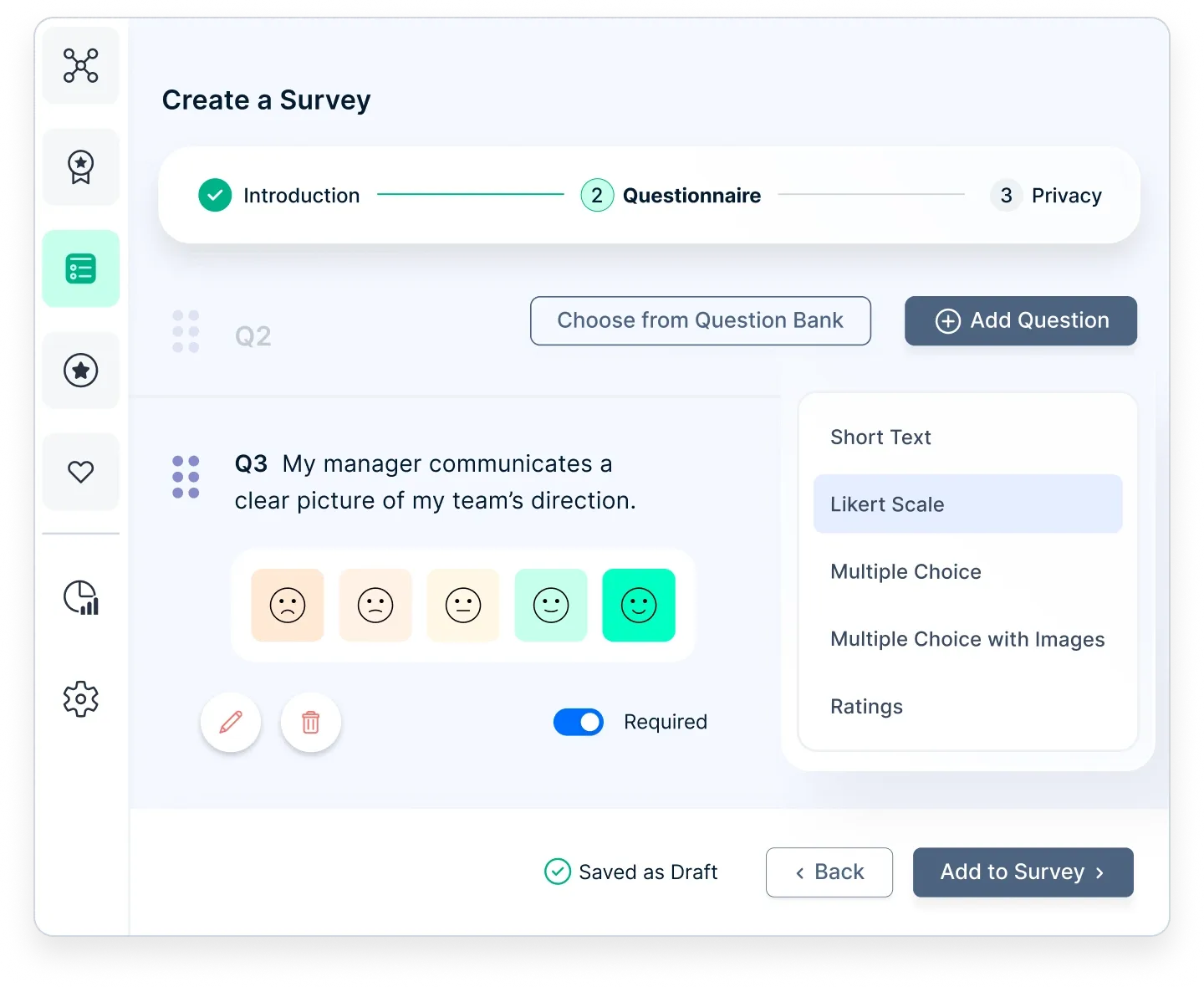
Turn Employee Feedback into Workplace Growth
Measure, analyze, and improve engagement with Empuls’ automated surveys. Get clear insights to create a happier and more productive workforce.
Different types of employee surveys
Employee surveys are valuable tools for organizations to understand their workforce's perspectives and improve the overall work environment.
There are various types of surveys, each focusing on specific aspects of the employee experience. Here's a breakdown of three common types:
1. Employee engagement surveys
Employee engagement refers to an employee's level of emotional commitment and connection to their work and organization. Engaged employees are highly motivated, productive, and loyal.
Several factors contribute to employee engagement, including:
- Meaningful work: Employees feel their work has a purpose and contributes to the organization's success.
- Growth opportunities: Employees have access to training and development programs that help them advance their skills and careers.
- Recognition and rewards: Employees feel appreciated for their contributions and are rewarded for their accomplishments.
- Supportive work environment: Employees feel valued and respected by their colleagues and managers, and they have the resources they need to be successful.
Employee engagement surveys are ideal for:
- Identifying engaged and disengaged employees: The survey results can help you segment your workforce into engaged, disengaged, and neutral groups. This allows you to focus your efforts on re-engaging disengaged employees and further motivating already engaged employees.
- Measuring progress against engagement initiatives: Regularly conducting engagement surveys helps you track your progress over time and assess the effectiveness of your engagement initiatives.
Sample questions for an employee survey that help you gauge their engagement:
- Do you feel valued at work?
- How frequently does your manager recognize your efforts?
- Do you have adequate access to learning and development tools?
- Do you believe that the management provides you enough
- autonomy to work independently?
2. Pulse surveys
Pulse surveys are short, frequent surveys designed to gather real-time feedback on specific topics.
Pulse surveys offer several advantages:
- Timeliness: They allow you to collect feedback quickly and address issues before they escalate.
- Actionable insights: The focused nature of pulse surveys provides targeted insights that can lead to immediate action.
- Increased participation: Due to their brevity, pulse surveys typically have higher participation rates compared to longer surveys.
Pulse surveys are ideal for:
- Gauging employee sentiment on specific initiatives: Following the launch of a new program or policy, a pulse survey can assess employee reaction and identify areas for improvement.
- Measuring employee engagement during periods of change: During mergers, acquisitions, or organizational restructuring, pulse surveys can help you track employee sentiment and address any concerns that arise.
Sample employee pulse survey questions include:
- On a scale of 1-5, how satisfied are you with the recent team-building activity?
- Do you feel you have the resources and support needed to successfully transition to the new workflow?
- How confident are you in the direction of the company following the recent leadership changes?
3. Employee satisfaction surveys
Employee satisfaction refers to an employee's overall contentment with their job and workplace. Satisfied employees are more likely to be happy, productive, and have lower absenteeism rates.
Low employee satisfaction can lead to decreased morale, reduced motivation, and higher turnover. By understanding what employees are satisfied and dissatisfied with, organizations can address areas of concern and improve overall morale.
Employee satisfaction surveys are ideal for:
- Measuring satisfaction with compensation and benefits: The survey can reveal employee sentiment regarding salary, benefits packages, and overall compensation competitiveness.
- Assessing work-life balance: Gathering feedback on workload, flexibility, and work-life balance helps identify potential areas for improvement.
- Evaluating company culture: Employees can express their opinions on company culture, leadership style, and communication channels.
Sample employee satisfaction survey questions:
- Do you like the company’s culture?
- Do you feel connected to your colleagues?
- Do you feel we are a dynamic organization?
- Is your feedback valued here?
- What is the primary source of company news for you?
- Do you feel that the management is transparent?
- Is the work distribution equitable in your team?
4. Exit survey
Exit interviews are conducted with departing employees to understand their reasons for leaving and gather valuable feedback on their overall experience at the organization.
Exit interviews offer crucial insights that can help organizations identify areas for improvement and address issues that might be leading to employee turnover.
Conduct exit interviews with all departing employees, regardless of their reason for leaving.
Sample questions (open-ended to encourage honest feedback):
- What triggered you to start looking for another job?
- What changes in our organization will attract you back to this firm?
- Were your efforts and contributions fully recognized here?
- What are things you like about this organization?
- What can the organization improve on?
5. Culture or diversity, equity & inclusion (DEI) survey
These surveys assess employee perceptions of your company's work environment, values, and inclusivity. They help identify areas where your company culture can be strengthened to foster a sense of belonging for all employees. It assesses the organization's workplace culture and its commitment to diversity, equity, and inclusion.
- Focus: Questions might address employee perceptions of respect, fairness, opportunities for advancement, and a sense of belonging for all employees.
- Benefits: Helps identify areas where the company culture can be strengthened to foster a more inclusive and positive work environment.
Sample culture or diversity, equity & inclusion (DEI) survey questions:
- Do you feel a sense of belonging within your team and organization?
- Do you believe your company provides equal opportunities for career advancement?
- Have you ever witnessed or experienced workplace discrimination?
- How confident are you that leadership prioritizes diversity and inclusion?
- Do you feel comfortable expressing your opinions without fear of bias?
Google collaborates with Performance Paradigm to redefine DEI with an innovative approach.
Google needs no introduction. The American multinational corporation and technology company, along with its parent company Alphabet, hordes around 182,500 full-time employees as of the end of 2023, making it very important for the organization to maintain diversity and cultural representation.
Google has made significant progress in increasing the representation of underrepresented groups in its workforce, particularly in leadership roles. The company has:
- Increased the number of Black, Latino, and Native American leaders by 30%, beating their goal by 3 years!
- Have more women than ever before in both technical and non-technical leadership roles, all around the world and in the USA.
- Hired more Black and Latino people than ever before, with Black employees making up 9.4% and Latino employees making up 9.0% of new hires in 2021.
Problem
Normally, many companies struggle to create diversity and inclusion (DEI) programs that work. Even when they try, the programs may not be effective.
With the company so vast and inclusive, how does Google maintain diversity, equity, and inclusion? It was a challenging task for Google, but achievable.
So, they partnered with Performance Paradigm, a company that consults businesses on DEI issues. Together, Google and Performance Paradigm created programs to help Google leaders and staff become more engaged in DEI.
The programs are designed to change the way people think about race, gender, and unconscious bias.
Solution
Just implementing a DEI program may not be effective. “For so long, we looked up at largely white men and asked them how the organization is doing on diversity, equity, and inclusion,” Michael Munoz, who leads diversity, equity, and inclusion within Marketing at Google, tells We First.
“We need to look at the Black, Latinx, Asian, indigenous populations and ask, ‘How are we doing at building a culture where you feel empowered and a strong sense of psychological safety?’”
- So, as a solution, they launched a program called Digital Human. The program concentrates on four key behaviors, including 'Show up', 'Be present', 'Creative visibility', and 'Proximate.' It includes workshops, exercises, and videos.
One activity that set the program apart from the rest was ‘2, 24, 25.’ The program allowed the managers to pick two people on their team, one that they knew fairly well and one that they barely knew.
Within 24 hours, schedule a 25-minute meeting with them and talk about them. The program lasts for 12 weeks.
The purpose was to increase the sense of belongingness. “We still used art and all the experiential things to deliver it, but we wouldn't let them fast forward. We wouldn't let them binge, they had to stop and do the work,” Butler claimed.
- Another program that they launched was called Examined Human. This program uses art and music to help people connect and learn about different cultures. These programs are designed to help Google create a more inclusive workplace where everyone feels like they belong.
- Implemented R.I.C.H dialogue to create community. “R.I.C.H. is an acronym for race, identity, culture, and heritage,” says Butler.
‘It's a type of communication tool that accelerates relationship management by exploring all the different points of view around race, identity, culture, and heritage.”
Impact
The DEI training at Google allowed the organization to see exceptional results.
- The DEI program dealt with the discomfort and allowed the marginalized, underrepresented people to feel included, and heard. Include a sense of belongingness.
- Facilitate communication and community building. Have a long-lasting impact.
6. Training surveys
Training surveys assess the effectiveness of training programs and employee learning experiences.
Training surveys provide valuable insights into whether training programs are meeting their objectives and equipping employees with the knowledge and skills they need to be successful.
Training surveys are ideal for:
- Measuring learning outcomes: Evaluate whether training programs are helping employees acquire the desired knowledge and skills.
- Gauging participant satisfaction: Assess employee satisfaction with the training program's content, delivery method, and overall effectiveness.
- Identifying areas for improvement: Gather feedback on how to refine and enhance future training programs.
Sample employee training survey questions:
- Did the content of the training meet your expectations?
- Was the trainer able to effectively answer your question?
- How do you rate the content and relevance of the training?
- How do you rate the instructor?
- How frequently should we conduct these training sessions?
7. 360-degree survey
360-degree feedback surveys provide a comprehensive evaluation of an employee's performance by gathering feedback from multiple sources, including peers, managers, subordinates, and sometimes even clients or customers.
360-degree feedback offers a well-rounded perspective on an employee's strengths and weaknesses, providing valuable insights for development.
360-degree feedback surveys are ideal for:
- Performance evaluation: When combined with self-assessment and manager feedback, 360-degree surveys provide a holistic view of employee performance.
- Identifying areas for development: The feedback can highlight specific areas where an employee can further develop their skills and knowledge.
Sample 360-degree survey questions:
- How effectively does this employee communicate with team members and other departments?
- How well does this employee handle constructive feedback and use it for improvement?
- How would you rate this employee’s leadership or teamwork skills?
- How effectively does this employee contribute to team goals and company objectives?
- What is one strength and one area for improvement for this employee?
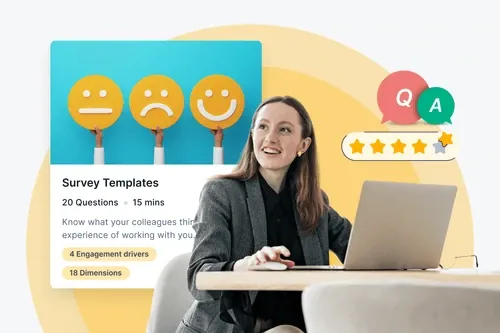
Download Free Employee Survey Templates for Instant Feedback
Get access to ready-to-use survey templates designed to capture valuable employee feedback. Whether you need engagement, DEI, or pulse surveys, find the right template to enhance your workplace experience.
The Do's and Don'ts of employee surveys
What you should do and should avoid while running an employee survey are written below:
The Do’s:
Do make your surveys successful by following these tips:
- Clearly explain why you're asking for feedback (communicate the purpose).
- Guarantee anonymity to get honest answers (keep responses anonymous).
- Highlight what's going well to boost morale (celebrate company successes).
- Share the results so employees see their voice matters (communicate survey results).
- Use easy-to-understand questions that avoid bias (use clear and unbiased questions).
- Keep it concise to avoid taking too much time (keep surveys short and focused).
- Use language employees understand (speak the employee's language).
- Think of surveys as interactions with your brand (treat surveys as brand interactions).
- Allow for detailed responses beyond yes/no answers (ask open-ended questions).
- Take action based on the feedback you receive (utilize survey results).
The Don’ts:
Avoid these mistakes that can make your employee surveys ineffective:
- Overwhelming employees with too many questions (ask too many questions).
- Surveying too frequently can lead to annoyance (deploy surveys too often).
- Asking for feedback without following up with actions (survey without acting).
- Phrases that nudge people towards a certain answer (ask leading questions).
- Underestimating how long it takes to complete the study (understate survey length).
- Discouraging participation due to too many surveys (creating survey fatigue).
However, just putting the ‘Do’s and Don’ts’ into practice will not suffice. You must know the best practices to perform throughout the time the employee survey is run.
Employee survey best practices
Effective employee surveys can provide valuable insights into company culture, employee satisfaction, and areas for improvement. Here's a breakdown of best practices for each stage of the survey process:
1. Before the survey
The ideation of the survey is just as important as the implementation of it. So, keep in mind the following details:
- Define your goals: Identify what you want to learn from the survey. Are you interested in employee engagement, work-life balance, or specific department processes? Focused goals will guide your question development.
- Build trust and anonymity: Employees need to feel comfortable providing honest feedback. Emphasize anonymity and confidentiality throughout the survey process.
- Craft clear questions: Use clear, concise, and unbiased language. Avoid jargon or leading questions that influence responses.
- Communicate effectively: Inform employees about the survey purpose, timeline, and how their feedback will be used. Encourage participation and address any concerns.
2. During the survey
During the survey, implement the following factors:
- Choose the right platform: Select a user-friendly platform that is accessible on various devices. Consider mobile-friendliness and ease of navigation.
- Keep it short: A concise survey with a reasonable completion time will improve participation rates. Prioritize the most important questions.
- Promote participation: Generate interest through internal communication channels. Use email reminders and highlight the importance of employee feedback.
3. After the survey
After the survey, consider doing the following:
- Analyze the data: Carefully analyze the results, identifying trends and areas requiring further investigation.
- Share the findings: Employees value transparency. Share key findings and explain how the feedback will be used to improve the workplace.
- Take action: Develop concrete action plans based on the survey results. Communicate these plans and demonstrate a commitment to addressing employee concerns.
Employee survey questions about management
Here are 30 essential employee survey questions about management, which can help organizations understand the strengths and weaknesses of their management practices and take steps to improve employee satisfaction and engagement.
Employee survey questions about management (communication)
A good supervisor-employee connection is built on clear and consistent communication. Frustration, uncertainty, and demotivation can result from poor dialogue at the top. Of course, identifying where dialogue may fail is not always straightforward.
These questions will help you identify areas where communication may be lacking or insufficient.
1. Has management communicated performance expectations?
2. Does your manager effectively communicate the information you need to understand?
3. Does the management explain the reasons for the decisions made?
4. Do managers resolve differences professionally?
5. Does your supervisor explain how the organization's plans affect you?
6. Does your boss communicate changes to company practices or benefits?
7. How often do you get recognition from your supervisor?
8. Were you recognized the last time you finished a project?
Employee survey question about management (trust & respect)
Trust is the foundation of all good relationships between employees and their superiors. Employees who don't feel safe and valued at work are less likely to ask questions, bring problems to management's attention, and feel motivated or empowered to do their best.
That's why it's so important for leaders to build trust and mutual respect in their teams. Here are some questions you can use to gauge how comfortable your employees are with their manager:
9. Does your manager create a trusting and open environment?
10. Does your supervisor treat all team members fairly?
11. Is your manager responsive to ideas, requests and suggestions?
12. When you approach your supervisor with a problem, do you trust him to listen?
13. Does your manager make you feel like a valuable part of the team?
Employee survey question about management (effectiveness)
14. How effective are your leaders at leading the organization?
15. Do they have the skills, training, and resources to succeed?
16. Do you have confidence in the performance of your immediate manager?
17. Does your manager have the knowledge and ability to support you and your team to succeed?
18. Does your boss maintain high standards of behavior?
19. Has your manager tried to improve things in the past year?
20. Does your manager consistently make effective decisions?
These are excellent questions to ask when the boss is doing everything right on paper, but the team is still sloppy. The responses can help spot possible gaps in a manager's skills or tools or resources that they may require to be successful.
Employee survey question about management (career development)
Career development is a key factor in employee engagement. Employees who see a future and growth path in their company will likely be engaged and motivated to
succeed. Managers play a key role in developing employees and providing growth opportunities.
These questions will help you see how well your managers train and develop their teams and identify opportunities to address communication or training gaps.
21. Do you and your supervisor discuss your career in this organization? 22. Do you find yourself
growing and developing your career in this company?
23. Do you know what steps you need to take to move up in the organization next year?
24. Do you believe you can reach your full potential here?
25. Do you have enough learning opportunities at work?
Employee survey question about management (work-life balance)
Work-life balance isn't just a nice thing to do; it's important to the well-being of your employees and, therefore, your bottom line. A poor balance between work and family life increases stress, employee burnout, and isolation. These questions will help you identify how well you manage work-life balance in your teams.
26. Does your supervisor understand the importance of your personal and family life?
27. Does your manager care about your well-being?
28. Is your workload generally reasonable for your role?
29. Does your supervisor set fair deadlines?
30. Do you feel supported by your manager?
Leverage Empuls employee survey tool: Unlock actionable insights to boost engagement
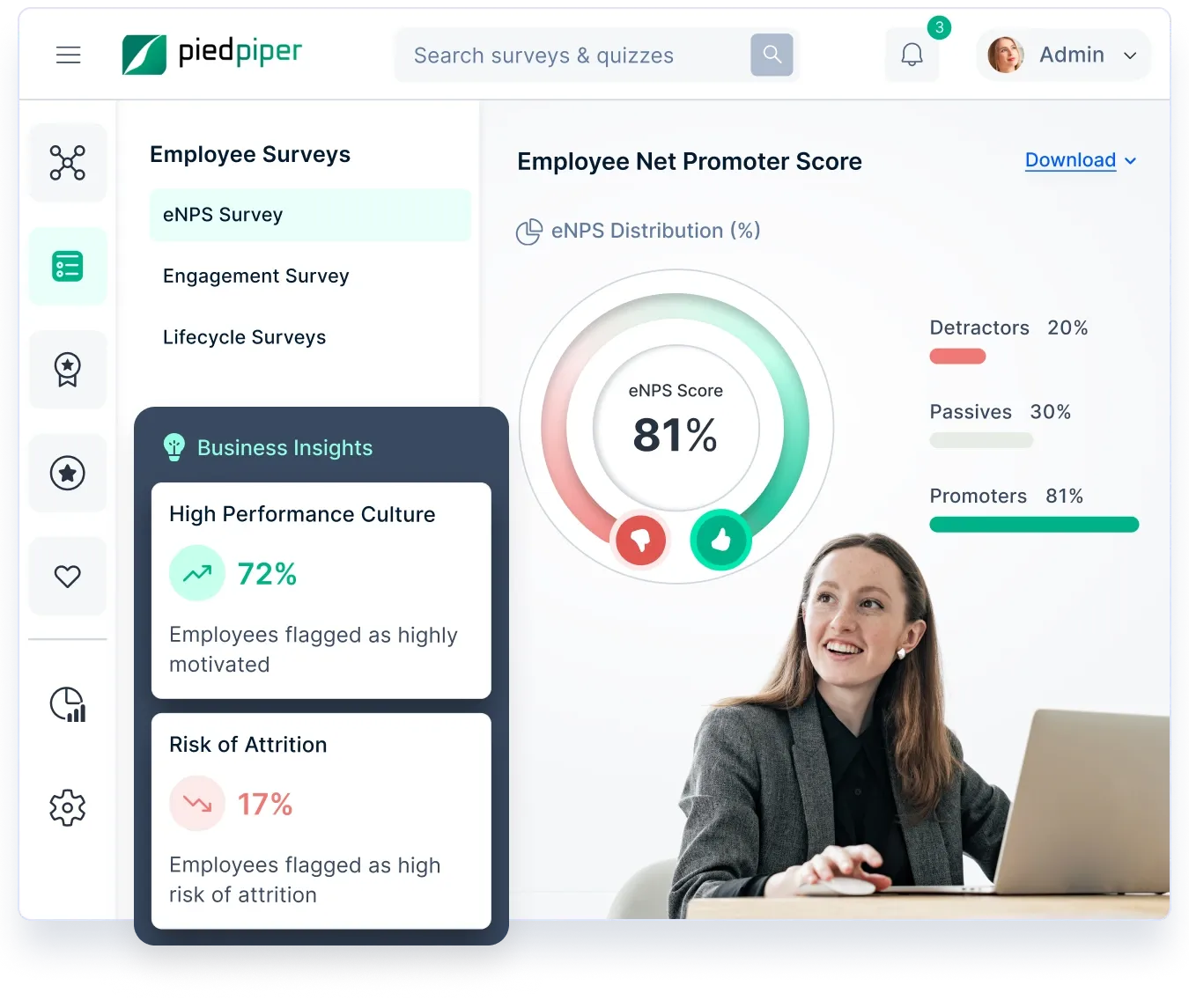
Understanding what drives employee satisfaction and productivity is the key to building a thriving workplace. Empuls’ employee survey tool helps organizations tap into employee sentiment, uncover real concerns, and take meaningful actions that drive engagement and retention. With a data-driven approach, Empuls makes feedback more than just a checkbox—it turns it into a strategic advantage.
1. Deep employee insights through engagement & pulse surveys
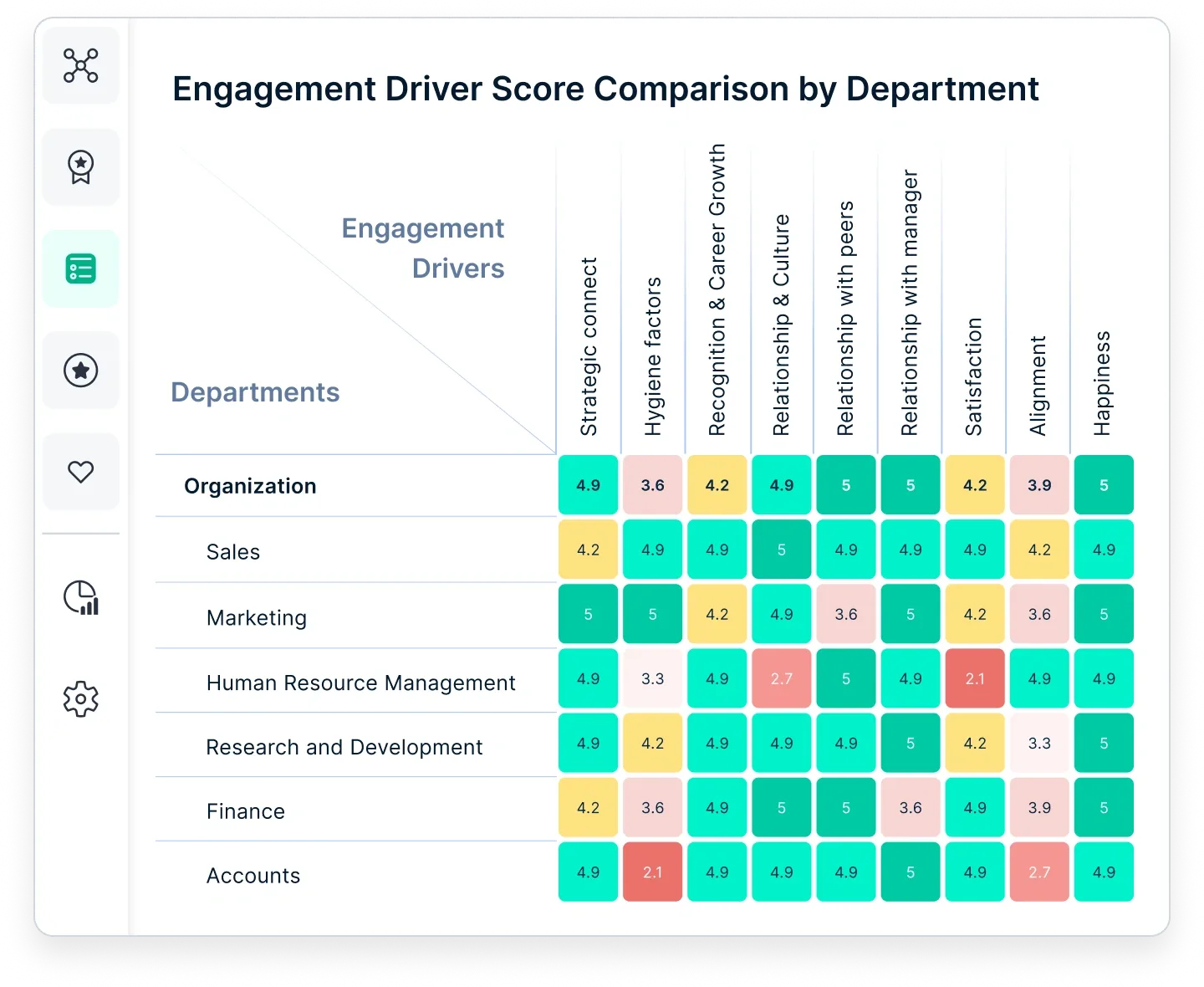
Traditional surveys often fail to capture the real pulse of an organization. Empuls changes this by offering real-time pulse surveys that go beyond surface-level questions.
With AI-powered sentiment analysis and trend tracking, leaders can detect signs of disengagement and address issues before they escalate. These insights help organizations create a continuously evolving workplace to meet employee needs.
2. Lifecycle surveys for every employee touchpoint
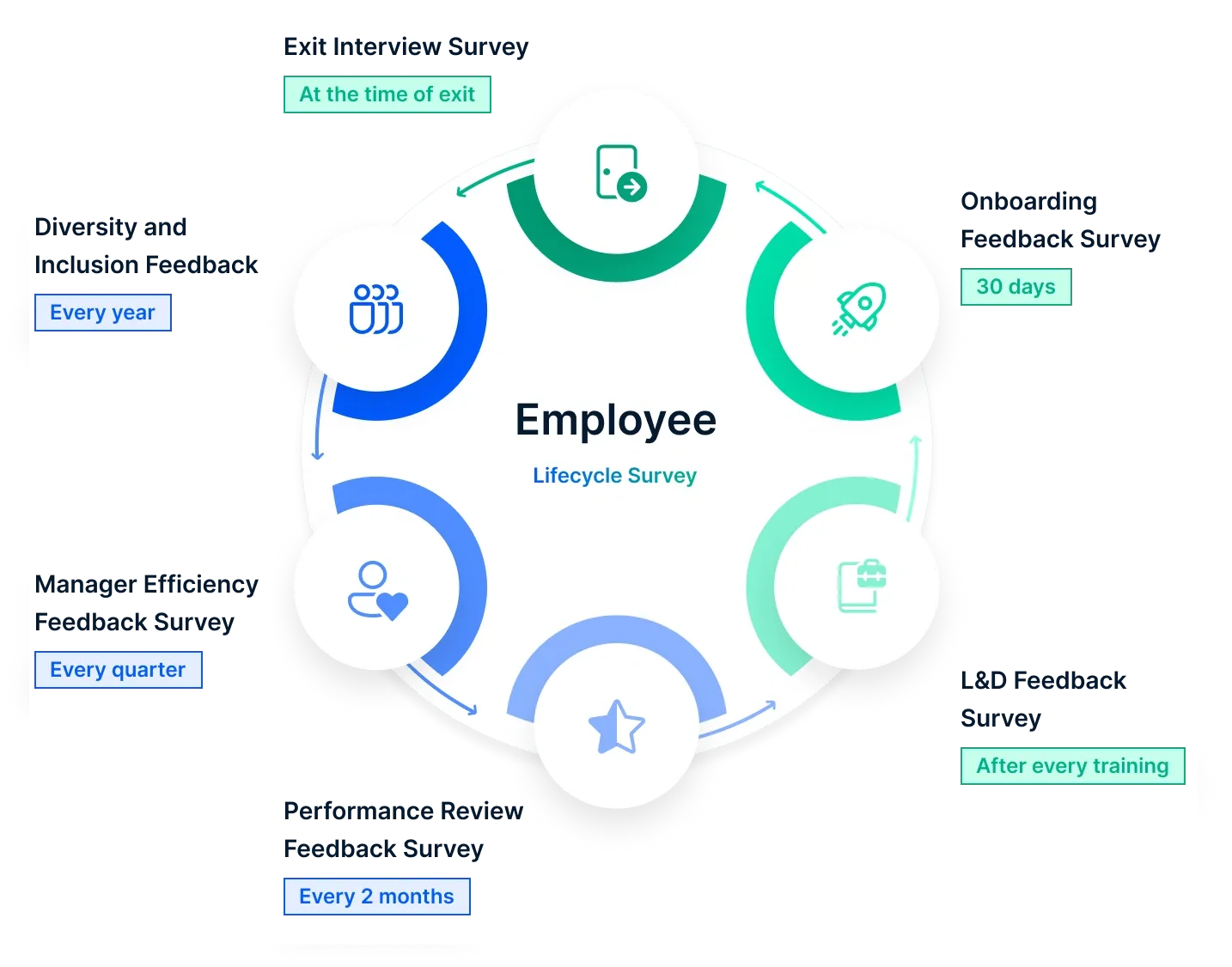
Employee experiences change over time, and a one-time survey is never enough. Empuls provides lifecycle surveys that track employee sentiment from onboarding to exit.
Organizations can use structured feedback loops to understand what’s working and what needs improvement at different stages of employment. Companies gain a well-rounded view of their workforce with specialized surveys covering DEIB, leadership effectiveness, and workplace culture.
3. Custom surveys for targeted feedback
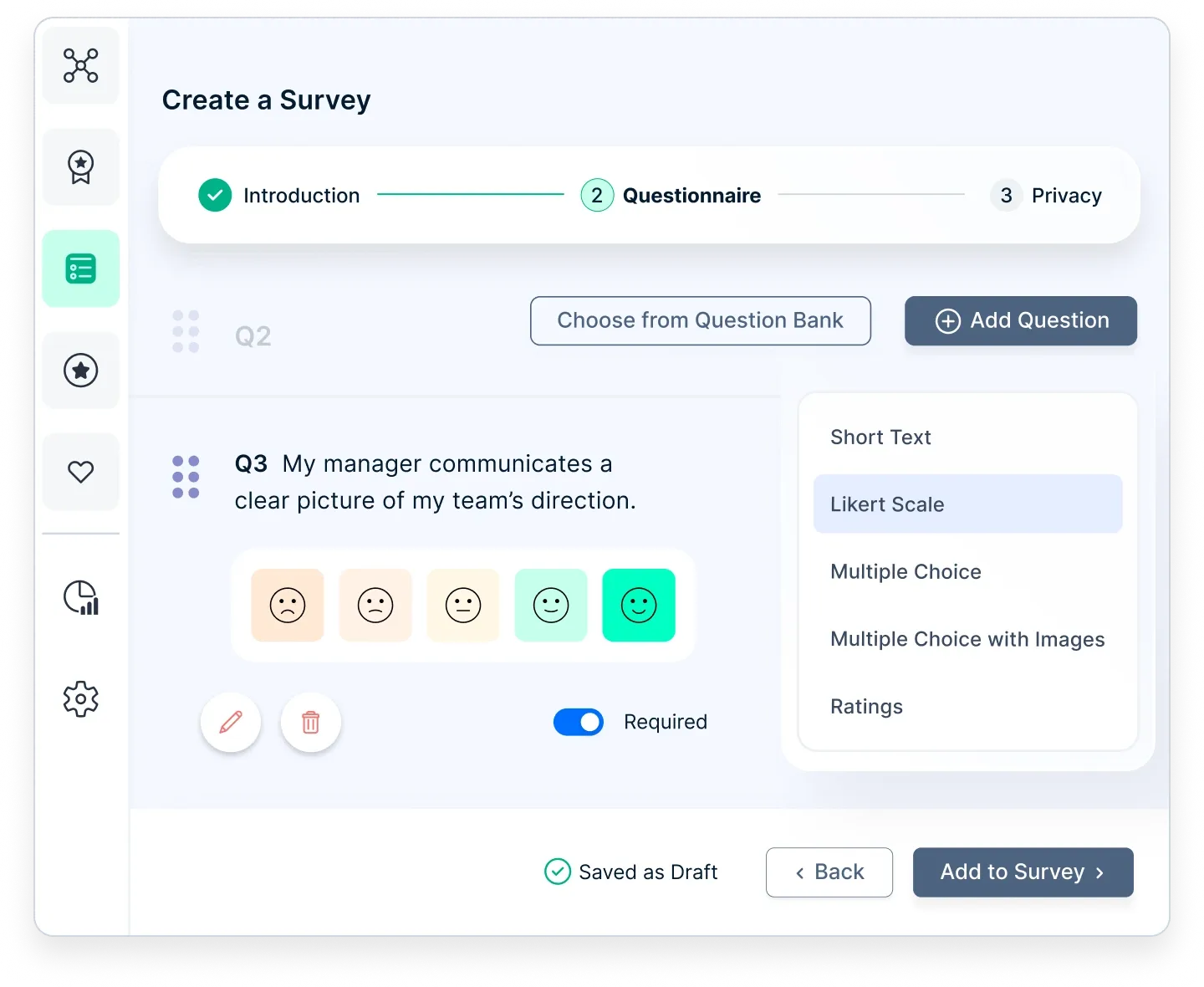
Every organization has unique challenges, and standard surveys don’t always fit the bill. Empuls enables companies to create fully customizable surveys focusing on their needs. With a rich question bank and the ability to design quizzes, businesses can capture precise insights that fuel better decision-making.
Whether measuring a new policy’s impact or understanding employee expectations, custom surveys make data collection more relevant and effective.
4. AI-driven conversations for honest feedback
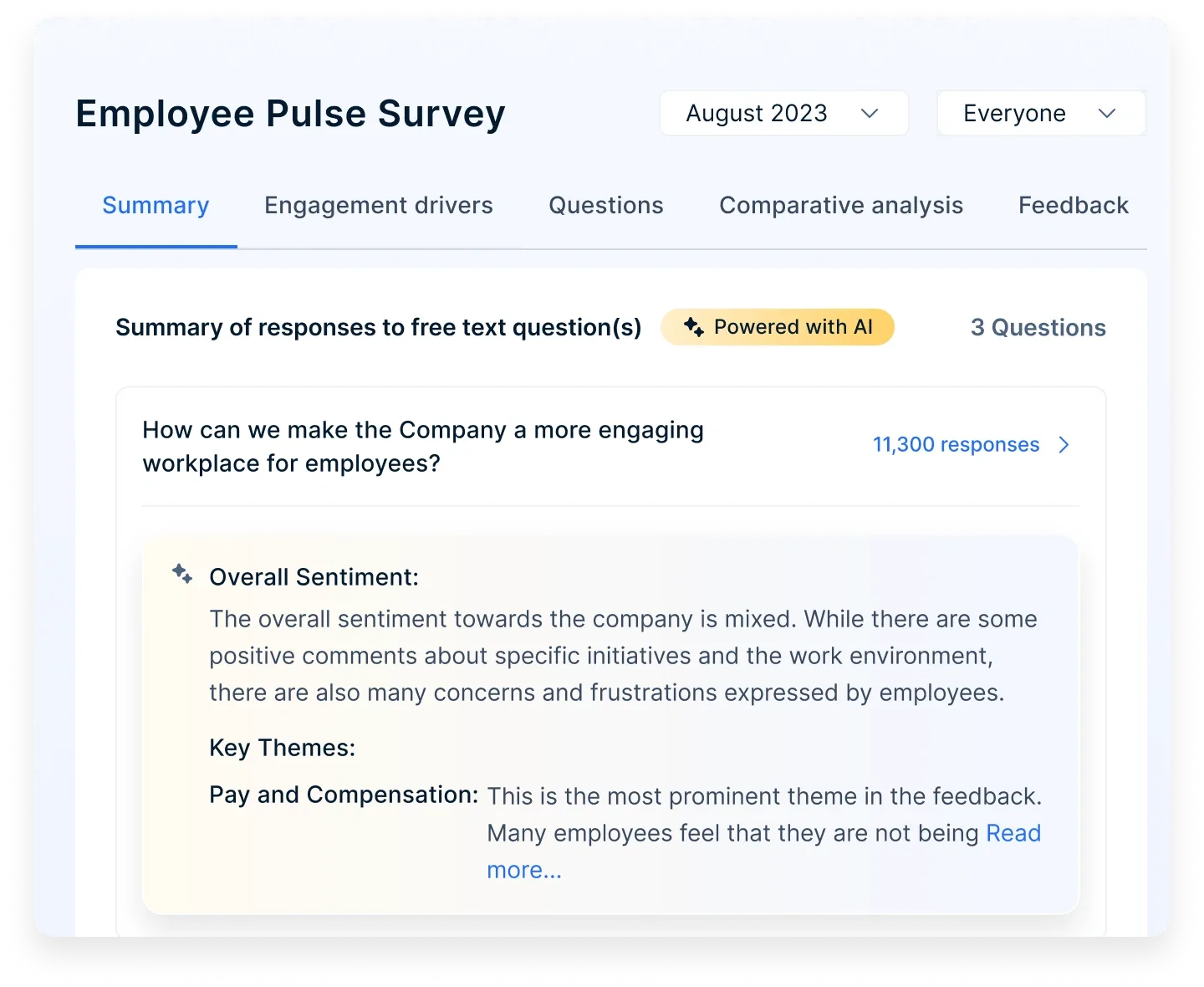
Employees often hesitate to provide candid feedback in traditional survey formats. Empuls overcomes this challenge with AI-driven conversations that feel natural and engaging.
By adapting questions in real-time based on responses, this tool encourages employees to share their true opinions. These personalized interactions make feedback more meaningful, helping organizations uncover issues that might go unnoticed.
5. Data-backed decisions with actionable reports
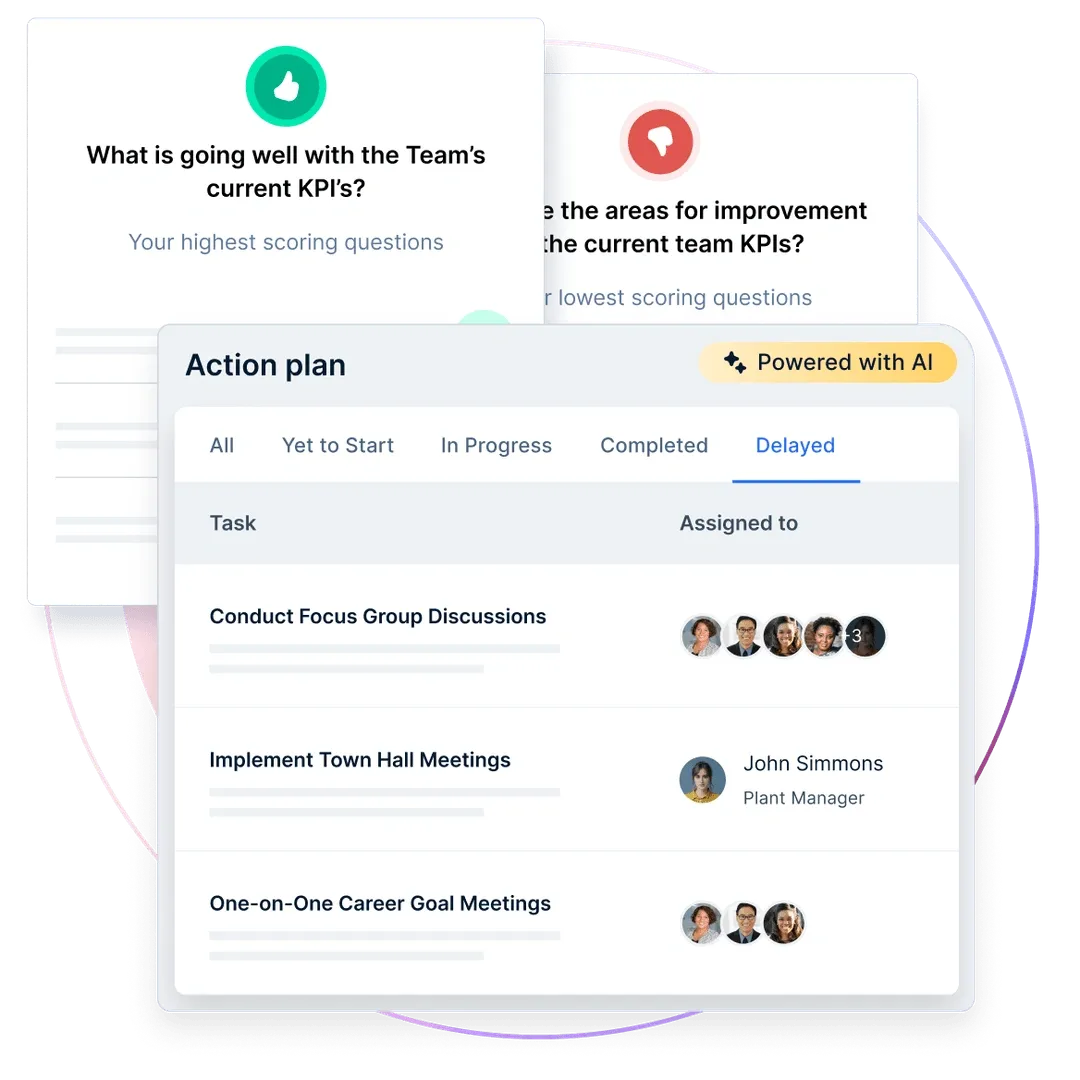
Gathering feedback is just the first step; acting on it makes a difference. Empuls turns survey results into detailed, visually rich reports highlighting key trends and pain points. Organizations can compare their performance against industry standards with AI-powered analytics and benchmarking tools.
Automated recommendations provide clear next steps, ensuring that survey insights lead to real improvements in employee engagement.
Turn feedback into meaningful change with Empuls
Empuls empowers HR leaders and managers to listen, act, and create a workplace where employees feel valued. Move beyond surveys—transform employee insights into measurable improvements that enhance culture and performance.
Ready to build an engaged workforce? Explore Empuls Employee Surveys Today
Conclusion
A well-structured employee survey lies in its ability to provide valuable insights into the health and well-being of your organization. Moreover, they are a confidential communication channel for employees to share their honest opinions and experiences. So, you can use employee surveys to turn the tide against employee disengagement and dissatisfaction among employees.
However, to align them with shared organizational values, motivate the employees, and reinforce positive behaviors to create a truly engaged work environment, you need a platform that goes beyond conducting just surveys.This is where Empuls can help. Empuls is an employee engagement platform that enables organizations to connect with employees. This holistic solution:
- Facilitate continuous feedback and improvement during the employee lifecycle using real-time surveys
- Helps plan data-driven employee engagement activities
- Fine-tunes action plans to improve eNPS
So, gather meaningful feedback, identify engagement drivers, and take data-driven actions to improve the employee experience and culture with Empuls.
FAQs
1. What are good survey questions for employees?
Good survey questions focus on engagement, job satisfaction, leadership, and workplace culture. Examples include: “Do you feel valued at work?”, “How likely are you to recommend this company as a great place to work?”, and “What improvements would enhance your experience?”
2. Are employee surveys a good idea?
Yes, employee surveys provide valuable insights into workplace sentiment, help identify issues and improve engagement. When conducted effectively, they can enhance employee satisfaction and contribute to better retention and performance.
3. Are employee surveys really anonymous?
Most employee surveys are anonymous, but it depends on how they are conducted. Organizations should clearly communicate anonymity policies to ensure employees feel safe providing honest feedback.
4. How often should companies conduct employee surveys?
The frequency of surveys depends on the organization’s goals. Annual surveys provide a broad overview, while quarterly or pulse surveys help track ongoing engagement and identify issues in real-time.
5. What are the different types of employee surveys?
Common types include engagement surveys, pulse surveys, exit surveys, onboarding surveys, and 360-degree feedback surveys. Each serves a different purpose, from measuring satisfaction to improving leadership effectiveness.
6. How can companies encourage honest employee feedback?
To get candid responses, companies should ensure surveys are anonymous, communicate how feedback will be used, and follow up with visible actions based on survey results. Creating a culture of trust makes employees more willing to share their thoughts.


















